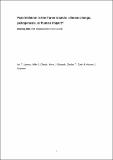Files in this item
Peat initiation in the Faroe Islands : climate change, pedogenesis or human impact?
Item metadata
| dc.contributor.author | Lawson, Ian T. | |
| dc.contributor.author | Church, Mike J. | |
| dc.contributor.author | Edwards, Kevin J. | |
| dc.contributor.author | Cook, Gordon T. | |
| dc.contributor.author | Dugmore, Andrew J. | |
| dc.date.accessioned | 2015-01-09T16:01:06Z | |
| dc.date.available | 2015-01-09T16:01:06Z | |
| dc.date.issued | 2007-03 | |
| dc.identifier.citation | Lawson , I T , Church , M J , Edwards , K J , Cook , G T & Dugmore , A J 2007 , ' Peat initiation in the Faroe Islands : climate change, pedogenesis or human impact? ' , Earth and Environmental Science Transactions Of The Royal Society Of Edinburgh , vol. 98 , no. 1 , pp. 15-28 . https://doi.org/10.1017/S1755691007000035 | en |
| dc.identifier.issn | 1755-6910 | |
| dc.identifier.other | PURE: 138566060 | |
| dc.identifier.other | PURE UUID: 78fa1664-e101-494f-a785-fde6ef22f1de | |
| dc.identifier.other | WOS: 000255545900003 | |
| dc.identifier.other | Scopus: 42149155977 | |
| dc.identifier.other | ORCID: /0000-0002-3547-2425/work/75996933 | |
| dc.identifier.uri | https://hdl.handle.net/10023/5982 | |
| dc.description.abstract | As an isolated island group lying off the NW. European mainland which was uninhabited until the mid-first millennium AD, the Farces offer a unique opportunity to study natural processes of Holocene ecosystem development in a region where anthropogenic activity is usually a complicating factor. In this paper new radiocarbon dates and pollen-analytical data from the island of Sandoy, in the centre of the Farces archipelago, are presented. Together with existing pollen and plant macrofossil records, these data allow a reconstruction of patterns of Holocene vegetational and edaphic change. Basal peat dates indicate that large areas of blanket mire were established long before the first human settlement, demonstrating conclusively that human impact is not necessary for the development of such ecosystems. The timing of the initiation of the blanket peats varies markedly, both across the Faroes as a whole and at a landscape scale, with dates distributed evenly over 9000 years. This suggests that, in the Faroes at least, pedogenesis was more important than climatic change in determining the timing of the spread of blanket peat systems. | |
| dc.format.extent | 14 | |
| dc.language.iso | eng | |
| dc.relation.ispartof | Earth and Environmental Science Transactions Of The Royal Society Of Edinburgh | en |
| dc.rights | Copyright © Royal Society of Edinburgh 2007. This work is made available online in accordance with the publisher’s policies. This is the author created, accepted version manuscript following peer review and may differ slightly from the final published version. The final published version of this work is available at http://dx.doi.org/10.1017/S1755691007000035 | en |
| dc.subject | Blanket peat | en |
| dc.subject | Holocene | en |
| dc.subject | Norse | en |
| dc.subject | Pollen | en |
| dc.subject | Radiocarbon | en |
| dc.subject | Blanket mire formation | en |
| dc.subject | Human settlement | en |
| dc.subject | Radiocarbon calibration | en |
| dc.subject | Lateral expansion | en |
| dc.subject | Landscape change | en |
| dc.subject | Western Norway | en |
| dc.subject | Early holocene | en |
| dc.subject | Vegetation | en |
| dc.subject | Sediments | en |
| dc.subject | GE Environmental Sciences | en |
| dc.subject | SDG 13 - Climate Action | en |
| dc.subject.lcc | GE | en |
| dc.title | Peat initiation in the Faroe Islands : climate change, pedogenesis or human impact? | en |
| dc.type | Journal article | en |
| dc.description.version | Postprint | en |
| dc.contributor.institution | University of St Andrews. Geography & Sustainable Development | en |
| dc.contributor.institution | University of St Andrews. Bell-Edwards Geographic Data Institute | en |
| dc.identifier.doi | https://doi.org/10.1017/S1755691007000035 | |
| dc.description.status | Peer reviewed | en |
This item appears in the following Collection(s)
Items in the St Andrews Research Repository are protected by copyright, with all rights reserved, unless otherwise indicated.

